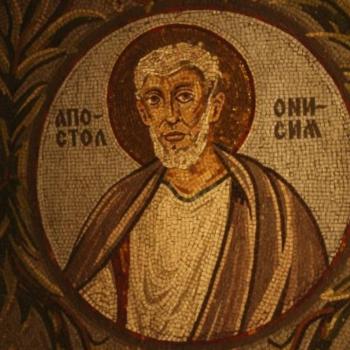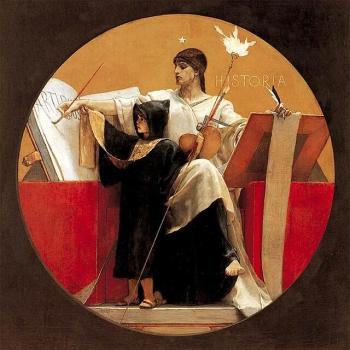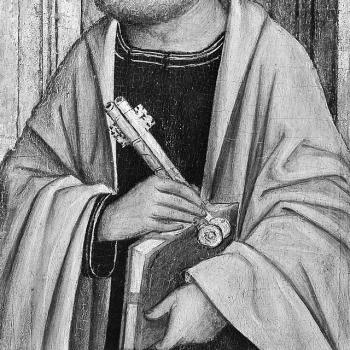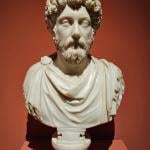Beginning today, I’m starting a weekly series on visions. My immediate interest in the question stems from my recent foray into the history of Mormonism, a movement that now traces itself to Joseph Smith’s theophany of God the Father and Jesus Christ. (See this recent statement on the subject published last year by the Church of Jesus Christ of Latter-day Saints).
Visions, theophanies and others, have a very long history in human religious experience, predating both Judaism and Christianity. In terms of Christianity, visions of Paul, Peter, John of Patmos, and others play key roles in the New Testament. From the Roman Emperor Constantine to Hildegard of Bingen, visions have played critical roles in Christian piety, missionary expansion, and developments both theological and political. Joseph Smith famously reported that a Methodist preacher rebuked him with the contention that “there was no such thing as visions or revelations in these days, that all such things had ceased with the apostles.” Of course, there were a goodly number of Methodists in the early 1800s who also saw and heard Jesus Christ and his Father. Today, many believers around the world live Christianity as a visionary faith. Most American Protestants, I reckon, do not.
Does God (and/or Jesus Christ) communicate with human beings through visions? Has God done this in the past and ceased to do so? Why do some religious believers receive visions while others do not? How has the human experience of visions changed across time and across cultures? What sorts of things might God reveal in visions? Only the confirmation of biblical teachings? Or different, new, and even contradictory information? More to the point, do people see God in dreams and visions? If so, how does what they see correspond with the reality or essence of God? In this series, I am hoping to think through some of these questions. Thus far in my life, it might be worth mentioning, I have been theophany-free.
The Hebrew scriptures are replete with visionary experiences, though the various Hebrew words translated into English as “vision” have somewhat different meanings. [My knowledge of Hebrew is both rusty and elementary]. For instance, when the “word of the Lord came to Abram in a vision” (Gen. 15:1, the term here is מַחֲזֶה), Abram presumably heard God’s voice and conversed with the Almighty while in a prophetic trance. Late in that same chapter, Abram appears to fall into an even deeper trance and then sees a flaming torch and smoking pot pass through a sacrifice that Abram has prepared.
The Hebrew scriptures describe the messages of many prophets as “visions.” For example, “The vision of Isaiah the son of Amoz, which he saw concerning Judah and Jerusalem” (Isaiah 1:1, the term here is חָזוֹן). Again, the word may suggest a prophetic trance, but with less of an emphasis on actually seeing something.
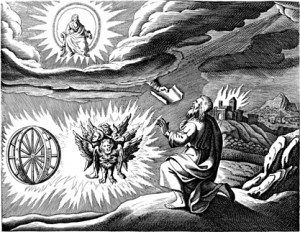
The apocalyptic books of the Hebrew scripture are the most visionary. For instance, Ezekiel reported that while among the exiled Judeans in Babylon, “the heavens were opened, and I saw visions of God.” (Ezekiel 1:1, the term here is מַרְאָה, implying seeing as through a looking glass or mirror) Ezekiel sees a great cloud, full of light and fire, out of which comes four living creatures with four faces each. The prophet then sees the “likeness of a throne,” and on the throne, “the likeness as it were of a human form.” This mighty being even had “the appearance of … loins,” which Paul Joyce labels “a particularly daring example of anthropomorphic language.” This, Ezekiel proclaims, is “the appearance of the likeness of the glory of the Lord.” When the prophet sees it, he falls to the ground. The vision assures Ezekiel that the glory of the Lord is with the exiles despite their distance from Jerusalem, but they must repent in order for the Lord to redeem them.
Visions and dreams are a central means of God’s revelation in scripture. In Numbers, Miriam and Aaron criticize Moses because Israel’s leader has married a Cushite woman. They observe that the Lord does not only speak through Moses. In fact, God has spoken through them. In response, God calls Miriam, Moses, and Aaron to the tent of meeting, comes down in a pillar of cloud, and makes an important distinction: “If there is a prophet among you, I the Lord make myself known to him in a vision, I speak with him in a dream. Not so with my servant Moses … With him I speak mouth to mouth … and he beholds the form of the Lord.” Moses’s experience is unusual, representing an even higher form of revelation. But God makes it clear that visions (the term here is the same as used in Ezekiel 1) and dreams are a normal form of communication between God and his prophets. Moreover, sometimes those visions contain spectacular theophanies. Note, though, that Ezekiel does not claim to have seen God. Instead, he claims to have seen the “appearance of the likeness” of God’s glory.
Other episodes in the Hebrew scriptures are often considered visions. For example, the Israelites in Exodus 19 see God’s glory. There is thunder and lightning, and a thick cloud forms upon Mount Sinai. Then “the Lord descended upon it in fire.” Moses speaks, and God answers in thunder. I would not classify this theophany as a vision, at least not as it is written in the text, because it seems that there really is a cloud and thunder for the people to see with their natural sight. Abraham sees things while in an altered state — it is unclear whether the torch and pot are actually there or not. Ezekiel makes it clear that he has received a vision, a revelation of God’s glory and message, not that God is actually sitting on a throne in his vicinity.
Biblical visions, such as Ezekiel’s and that of John of Patmos, strongly shaped the way that Christians envisioned God. They also shaped the way that many early Christians expected to experience God. Other early Christians, however, concluded that the era of visions had passed.




